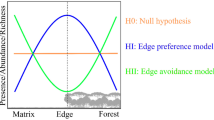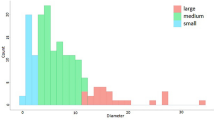Abstract
The goal of this study was to identify causes for lower population densities of mouse lemurs (Microcebus murinus) in secondary than in primary dry deciduous forests of western Madagascar. Variations in the abundance of Microcebus murinus are linked to the capacity to enter energy-saving torpor during the dry season. Under natural conditions in primary forest, Microcebus murinus can maintain daily torpor (and possibly hibernation) as long as body temperatures remain below 28°C. Females are more likely to hibernate than males, resulting in skewed sex ratios of captured Microcebus murinus in the primary forest. In the secondary forest the sex ratio of subjects captured during the dry season is more balanced than in primary forest, indicating that fewer females go into torpor in secondary than in primary forest. Secondary forests have fewer large standing or fallen trees that might provide holes as shelter for Microcebus murinus. Ambient temperatures are higher in secondary than in primary forests and higher outside than inside tree holes. These high ambient temperatures might hinder the ability of Microcebus murinus to maintain torpor for prolonged periods in secondary forests. Mouse lemurs from secondary forest have lower body mass than in primary forest. The year-to-year recapture rate is zero in secondary forest and thus significantly lower than in primary forest. This indicates that survival rates are lower in secondary than in primary forests. Thus, secondary forests may be of limited value as buffer zones or even corridors for mouse lemurs.
Similar content being viewed by others
REFERENCES
Abraham, J.-P., Rakotonirina, B., Randrianasolo, M., Ganzhorn, J. U., Jeannoda, V., and Leigh, E. G. (1996). Tree diversity on small plots in Madagascar: A preliminary review. Rev. d'Ecologie 51: 93–116.
Bourlière, F., and Petter-Rousseaux, A. (1966). Existence probable d'un rythme métabolique saisonnier chez les Cheirogaleinae (Lemuroidea). Folia Primatol. 4: 249–256.
Chevillard, M.-C. (1976). Capacités thermorégulatrices d'un lémurien malgache, Microcebus murinus (Miller, 1777), Dissertation, Université Paris, Paris.
Donque, G. (1975). Contribution géographique à l'étude du climat de Madagascar, Nouvelle Imprimerie des Arts Graphiques, Tananarive.
Fietz, J. (1995). Paarungs-und Sozialsystem von Microcebus murinus (J. F. Miller 1777), Diplom, Universität Tübingen, Tübingen.
Fietz, J. (1998). Body mass in wild Microcebus murinus over the dry season. Folia Primatol. 183–190.
Ganzhorn, J. U. (1992). Leaf chemistry and the biomass of folivorous primates in tropical forests. Oecologia 91: 540–547.
Ganzhorn, J. U. (1995). Low level forest disturbance effects on primary production, leaf chemistry, and lemur populations. Ecology 76: 2084–2096.
Ganzhorn, J. U. (1996). Causes for lemur population decline in degraded and secondary forests of the Morondava region. In Patterson, B. D., Goodman, S. M., and Sedlock, J. L. (eds.), Environmental Change in Madagascar, Field Museum of Natural History, Chicago, p. 39.
Ganzhorn, J. U., and Sorg, J.-P., (eds.) (1996), Ecology and Economy of a Tropical Dry Forest, Vol. 46-1, Primate Report, Special Volume, Göttingen.
Ganzhorn, J. U., Rakotosamimanana, B., Hannah, L., Hough, J., Iyer, L., Olivieri, S., Rajaobelina, S., Rodstrom, C., and Tilkin, G. (1997). Priorities for Biodiversity Conservation in Madagascar, Vol. 48-1, Primate Report, Göttingen.
Ganzhorn, J. U., Langrand, O., Wright, P. C., O'Connor, S., Rakotosamimanana, B., Feistner, A. T. C., and Rumpler, Y. (1996/1997). The state of lemur conservation in Madagascar. Primate Conserv. 17: 70–86.
Goodman, S. M., O'Connor, S., and Langrand, O. (1993). A review of predation on lemurs: implications for the evolution of social behavior in small nocturnal primates. In Kappeler, P. M., and Ganzhorn, J. U. (eds.), Lemur Social Systems and Their Ecological Basis, Plenum Press, New York, pp. 51–66.
Hawkins, A. F. A., Chapman, P., Ganzhorn, J. U., Bloxam, Q. M. C., Barlow, S. C., and Tonge, S. J. (1990). Vertebrate conservation in Ankarana and Analamera Special Reserves, northern Madagascar. Biol. Conserv. 54: 83–110.
Kent, M., and Coker, P. (1992). Vegetation Description and Analysis, CRC Press, Boca Raton, FL.
Martin, R. D. (1972). A preliminary study of the lesser mouse lemur (Microcebus murinus J.F. Miller 1777). Z. Comp. Ethol. Suppl. 9: 43–89.
Martin, R. D. (1973). A review of the behavior and ecology of the lesser mouse lemur (Microcebus murinus). In Michael, R. P., and Crook, J. H. (eds.), Comparative Ecology and Behavior of Primates, Academic Press, London, pp. 1–68.
Mittermeier, R. A., Konstant, W. R., Nicoll, M. E., and Langrand, O. (1992). Lemurs of Madagascar: An Action Plan for Their Conservation 1993–1999, IUCN, Gland, Switzerland.
Ortmann, S., Schmid, J., Ganzhorn, J. U., and Heldmaier, G. (1996). Body temperature and torpor in a Malagasy small primate, the mouse lemur. In Geiser, F., Hulbert, A. J., and Nicol, S. C. (eds.), Adaptations to the Cold: The Tenth International Hibernation Symposium, University of New England Press, Armidale, pp. 55–61.
Ortmann, S., Heldmaier, G., Schmid, J., and Ganzhorn, J. U. (1997). Spontaneous daily torpor in Malagasy mouse lemurs. Naturwissenschaften 84: 28–32.
Petter, J. J., Albignac, R., and Rumpler, Y. (eds.) (1977). Faune de Madagascar: Mammifères Lémuriens, Vol. 44, OSTOM CNRS, Paris.
Petter-Rousseaux, A. (1980). Seasonal activity rhythms, reproduction, and body weight variations in five sympatric nocturnal prosimians, in simulated light and climatic conditions. In Charles-Dominique, P., Cooper, H. M., Hladik, A., Hladik, C. M., Pages, E., Pariente, G. F., Petter-Rousseaux, A., Petter, J.-J., and Schilling, A. (eds.), Nocturnal Malagasy Primates, Academic Press, New York, pp. 137–152.
Rakotonirina (1985). La pluviométrie dans la concession forestière du CFPF de Morondava (1979–1984). Fiche Technique No 9, Centre de Formation Professionnelle Forestière, Morondava.
Rakotonirina (1996). Composition and structure of a dry forest on sandy soils near Morondava. In Ganzhorn, J. U., and Sorg, J.-P. (eds.), Ecology and Economy of a Tropical Dry Forest in Madagascar, Primate Report, 46-1, Göttingen, pp. 81–87.
Rasoloarison, R. M., Rasolonandrasana, B. P. N., Ganzhorn, J. U., and Goodman, S. M. (1995). Predation on vertebrates in the Kirindy Forest, western Madagascar. Ecotropica 1: 59–65.
Schmid, J. (1996). Oxygen consumption and torpor in mouse lemurs (Microcebus murinus and M. myoxinus): Preliminary results of a study in western Madagascar. In Geiser, F., Hulbert, A. J., and Nicol, S. C. (eds.), Adaptations to the Cold: The Tenth International Hibernation Symposium, University of New England Press, Armidale, pp. 47–54.
Schmid, J. (1997). Torpor beim Grauen Mausmaki (Microcebus murinus) in Madagaskar: Energetische Konsequenzen und ökologische Bedeutung, Dissertation, Universität Tübingen, Tübingen.
Schmid, J. (in press). Sex specific differences in the activity pattern and the regulation of energy stores in the grey mouse lemur (Microcebus murinus) in Madagascar. J. Mammalogy.
Schmid, J., and Smolker, R. (1998). Lemurs of the Réserve Spéciale d'Anjanaharibe-Sud, Madagascar. In Goodman, S. M. (ed.), Fieldiana, Zoology 90, Field Museum Natural History, Chicago, pp. 227–238.
Smith, A. P., Horning, N., and Moore, D. (1997). Regional biodiversity planning and lemur conservation with GIS in western Madagascar. Conserv. Biol. 11: 498–512.
Sorg, J.-P. (1996). L'étude de la végétation, un outil au service de l'amenagement et de la gestion des ressources forestières à Madagascar. Akon'ny Ala 18: 26–36.
von Schulthess, L. (1990). Inventaire de l'évolution des formations secondaires comme base pour leur conversion en forêts de production, Diplom, Fachbereich Wald-und Holzforschung, ETH Zürich.
Author information
Authors and Affiliations
Rights and permissions
About this article
Cite this article
Ganzhorn, J.U., Schmid, J. Different Population Dynamics of Microcebus murinus in Primary and Secondary Deciduous Dry Forests of Madagascar. International Journal of Primatology 19, 785–796 (1998). https://doi.org/10.1023/A:1020337211827
Issue Date:
DOI: https://doi.org/10.1023/A:1020337211827




